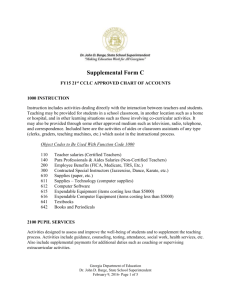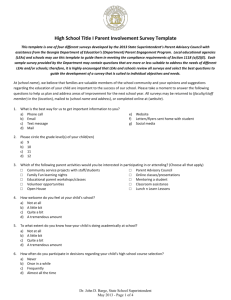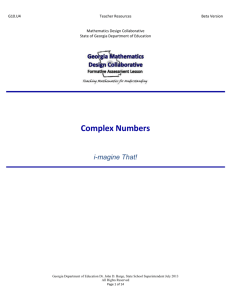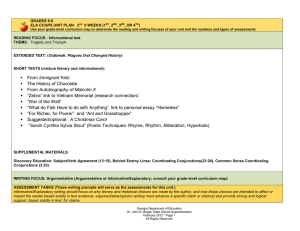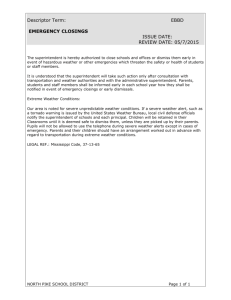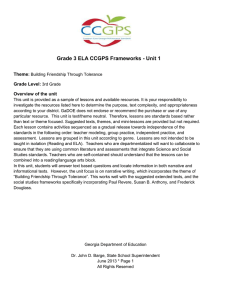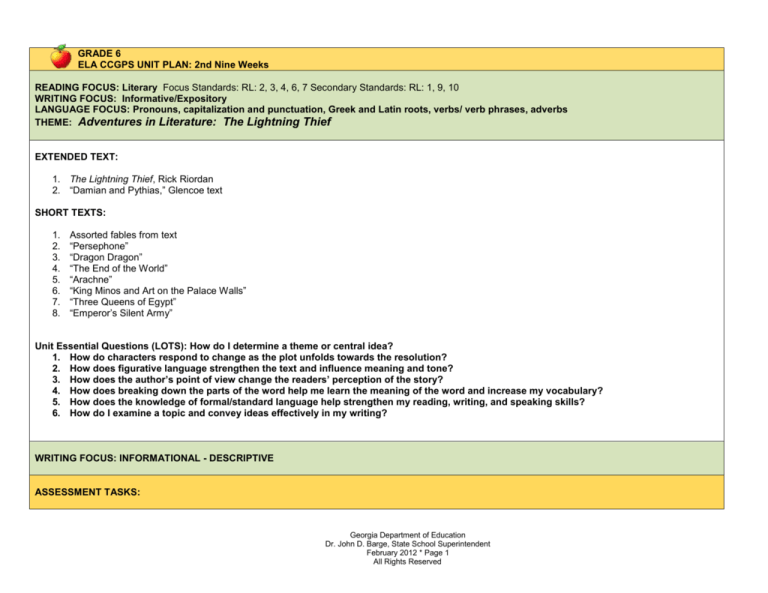
GRADE 6
ELA CCGPS UNIT PLAN: 2nd Nine Weeks
READING FOCUS: Literary Focus Standards: RL: 2, 3, 4, 6, 7 Secondary Standards: RL: 1, 9, 10
WRITING FOCUS: Informative/Expository
LANGUAGE FOCUS: Pronouns, capitalization and punctuation, Greek and Latin roots, verbs/ verb phrases, adverbs
THEME: Adventures in Literature: The Lightning Thief
EXTENDED TEXT:
1. The Lightning Thief, Rick Riordan
2. “Damian and Pythias,” Glencoe text
SHORT TEXTS:
1.
2.
3.
4.
5.
6.
7.
8.
Assorted fables from text
“Persephone”
“Dragon Dragon”
“The End of the World”
“Arachne”
“King Minos and Art on the Palace Walls”
“Three Queens of Egypt”
“Emperor’s Silent Army”
Unit Essential Questions (LOTS): How do I determine a theme or central idea?
1. How do characters respond to change as the plot unfolds towards the resolution?
2. How does figurative language strengthen the text and influence meaning and tone?
3. How does the author’s point of view change the readers’ perception of the story?
4. How does breaking down the parts of the word help me learn the meaning of the word and increase my vocabulary?
5. How does the knowledge of formal/standard language help strengthen my reading, writing, and speaking skills?
6. How do I examine a topic and convey ideas effectively in my writing?
WRITING FOCUS: INFORMATIONAL - DESCRIPTIVE
ASSESSMENT TASKS:
Georgia Department of Education
Dr. John D. Barge, State School Superintendent
February 2012 * Page 1
All Rights Reserved
1.
2.
3.
4.
5.
6.
7.
Create a cabin for a mythological character. Describe it, citing reasons based on traditional literature.
Research a national site or city and create a setting/characters for a new chapter in the book.
Create an urban legend and develop a wanted poster for the creature.
Compare and contrast essay – novel to the motion picture.
Urban legend storytelling around the “campfire” (listening, speaking, and viewing)
Reader’s Theater (sequel or prequel) - narrative
(3 of 4 must be informational-explanatory)
NARRATIVE/RESEARCH/ROUTINE WRITING
NARRATIVE
1. Create a short story for your urban legend.
2. Dramatize your story and present it at culminating campfire.
RESEARCH CONNECTIONS or PROJECTS:
1.
2.
2.
3.
Research a climate for a new urban legend.
Map work centering around urban legend wanted poster
Novel extension: Book Mosaic or Comic Strip
Novel extension: Business letter – pitch a movie idea based on a novel
ROUTINE WRITING Notes, summaries, process journals, and short responses across all genres
Reading response journal
“Pump It Up” Friday
Daily Oral Language sentences. paragraphs and assessments
Use It or Lose It
PLANS FOR ASSESSMENT 1: integrating reading selections from the unit into a writing task
Descriptive Text Choice Board:
Create a new cabin for a mythological character. Draw a picture of the cabin and write a description of the cabin and its furnishings, using evidence from
traditional mythology to support your choices.
Transform an existing historical or tourist landmark into a setting for a new Percy adventure. Describe the setting in writing and create new antagonists based
Georgia Department of Education
Dr. John D. Barge, State School Superintendent
February 2012 * Page 2
All Rights Reserved
on traditional mythology. Alternate activity: cities suitable for gifted clusters.
As new manager of the Lotus Casino, it is your job to design a new room that teenagers will never want to leave. Make connections with mythological symbols
as you create your environment and describe it in text.
SKILL BUILDING TASKS
Note: tasks may take more than a single day. Include a task to teach EVERY skill students will need to succeed on the assessment prompt above. Language,
Foundations, and Speaking/Listening standards must be incorporated so that all standards are adequately addressed throughout the year.
ESSENTIAL QUESTION:
How does the author’s point of view change the readers’ perception of the story?
How does figurative language strengthen the text and influence meaning and tone?
TASK: Reading and response to literature; extended activities related to writing
Standards:
KNOW and UNDERSTAND (What students
must know and understand based on LOTS)
Students will be able to read and understand text
at the sixth grade level
Students will understand the theme of text and
understand the deeper meaning of figurative
language present in the text.
Students will know the connection that exists
between art and literature.
Students will understand that traditional literature
has changed over time.
Students will understand the correlation between
literary texts to other literary texts and literary text
to informational texts.
DO (What students must do based on LOTS)
Students will read the Lightning Thief and be able
to make connections to mythology.
Students will write a prequel/sequel to the novel
using a new setting including a national landmark
or city.
Students will be able to extend their knowledge
about literary text to complete a task from a
differentiated choice board that includes designing
a cabin, new room in a venue, or a full-size
character.
Student will effectively incorporate figurative
language into reader’s theater or task from the
choice board.
Students will complete a close read activity using
artwork based on cultural mythology.
Students will complete a close read of a selection
from the original Grimm’s fairy tales.
Students will read shorter selections of related text
and make connections and extensions based on
the setting, point of view, theme and literary
elements of both the novel and the short texts.
Georgia Department of Education
Dr. John D. Barge, State School Superintendent
February 2012 * Page 3
All Rights Reserved
Bloom’s or DOK—Based on the action of the
student
DOK2
DOK3
DOK3 and 4
DOK3
BALANCED ASSESSMENTS:
Pre-Assessment and/or Diagnostic:
Grammar relating to pronouns, Greek and Latin roots, adverbs and verbs.
Vocabulary pretest – vocabulary of the standards.
Formative:
Research product
Descriptive writing/cabin
Plot diagram for prequel/sequel
Language graphic organizers and notes
Summative:
Reading comprehension assessment
Language (grammar
Prequel/sequel
QPA second nine week
DIFFERENTIATION:
Scaffolding:
Gifted Cluster and Enrichment: Tiered lessons for gifted.
Instruction Plan:
PLANS FOR ASSESSMENT 2: integrating reading selections from the unit into a writing task
PROMPT: Why did movie producers change the movie version of the book so drastically? Write a main idea/supporting details essay and support your
reasons citing specific examples from book and movie.
SKILL BUILDING TASKS
Note: tasks may take more than a single day. Include a task to teach EVERY skill students will need to succeed on the assessment prompt above. Language,
Foundations, and Speaking/Listening standards must be incorporated so that all standards are adequately addressed throughout the year.
ESSENTIAL QUESTION
How do I examine a topic and convey ideas effectively in my writing?
Georgia Department of Education
Dr. John D. Barge, State School Superintendent
February 2012 * Page 4
All Rights Reserved
TASK: Students will write a compare and contrast essay
Standards:
KNOW and UNDERSTAND (What students
must know and understand based on LOTS)
Students will understand the writing process and
the unique organization of compare and contrast
text structure.
Students understand the role of transitions in
writing.
Students will understand the importance of using
strong verbs and adverbs in their writing.
DO (What students must do based on LOTS)
Bloom’s or DOK—Based on the action of the
student
Students will complete a thinking map/graphic
organizer during a prewriting process to
demonstrate their understanding of the
compare/contrast concept. Students will
effectively use revising skills to improve their
writer rather than simply edit their own text.
Students will avoid using elementary transitions;
rather they shall use more advanced compare and
contrast transitions in their essay.
Students will be able to evaluate their own work
and that of their peers to evaluate the use of verbs
and suggest more powerful verbs and adverbs in
their work.
NOTE: May have to add more rows depending on the number of standards for the tasks.
BALANCED ASSESSMENTS:
Pre-Assessment and/or Diagnostic:
Formative:
Venn diagram or thinking map
Rough draft
Peer editing
Summative:
Final product
Instruction Plan:
Also, LABEL the Components of the TASK as Acquisition, Application, Assimilation, and/or Adaptation
Differentiation:
Gifted cluster students would compare contrast different Riordan texts and create their own proposal, rubric, and compare and contrast product of their own
Georgia Department of Education
Dr. John D. Barge, State School Superintendent
February 2012 * Page 5
All Rights Reserved
choice.
Scaffolding:
Small group instruction, lunch tutoring, slotted notes.
ESSENTIAL QUESTION: How does breaking down the parts of the word help me learn the meaning of the word and increase my vocabulary?
TASK: Greek and Latin root word practice.
Standards:
KNOW and UNDERSTAND (What students
must know and understand based on LOTS)
Students will understand that words are
constructed from roots and affixes.
DO (What students must do based on LOTS)
Students will be able to determine meaning from
words by breaking words into components based
on common Greek and Latin roots.
Bloom’s or DOK—Based on the action of the
student
DOK2
BALANCED ASSESSMENTS:
Pre-Assessment and/or Diagnostic:
Students will complete a pre-assessment determining prior knowledge of Greek and Latin roots.
Formative:
Students will complete traditional practice exercises using roots correctly.
Summative:
Students will complete traditional quizzes including exercises where they construct words correctly using affixes.
Instruction Plan: (Be sure to include in detail the role of the teacher and the role of the student.)
Include vocabulary (Tier 2 and 3).
Also, LABEL the Components of the TASK as Acquisition, Application, Assimilation, and/or Adaptation
PLANS FOR ASSESSMENT 3: integrating reading selections from the unit into a writing task
PROMPT: Create a “new” urban legend or god or goddess and write a narrative complete with appropriate plot details (setting, exposition, conflict, climax, and
Georgia Department of Education
Dr. John D. Barge, State School Superintendent
February 2012 * Page 6
All Rights Reserved
resolution).
SKILL BUILDING TASKS
Note: tasks may take more than a single day. Include a task to teach EVERY skill students will need to succeed on the assessment prompt above. Language,
Foundations, and Speaking/Listening standards must be incorporated so that all standards are adequately addressed throughout the year.
ESSENTIAL QUESTION: How do characters respond to change as the plot unfolds towards the resolution?
TASK: Students will create a character, setting, and short narrative connected to literary texts in this unit.
Standards:
KNOW and UNDERSTAND (What students
must know and understand based on LOTS)
Students will understand the unique
characteristics of a narrative.
Students will understand the importance of
character traits and the concept of a moral or
lesson.
Students will understand that conflict is essential
to a short narrative.
Students will know that unique characteristics of
setting lend interest to a story.
Students will know the effective ways to deliver an
oral presentation.
DO (What students must do based on LOTS)
Students will construct a simple plot diagram for
their creature.
Students will complete a wanted poster or full size
mythological character and associate both
physical and emotional traits to the character.
Students will include internal or external conflict in
their narrative.
Students will research a climate and associate
characteristics of that climate in their story.
Students will effectively deliver their story in a
group sharing exercise.
NOTE: May have to add more rows depending on the number of standards for the tasks.
BALANCED ASSESSMENTS:
Pre-Assessment and/or Diagnostic:
Activating strategy – parts of a story or language of a narrative
Formative:
Plot diagram
Rough draft check or peer editing check
Summative:
Oral presentation rubric
QPA Assessment
Differentiation:
Georgia Department of Education
Dr. John D. Barge, State School Superintendent
February 2012 * Page 7
All Rights Reserved
Bloom’s or DOK—Based on the action of the
student
DOK2
DOK3
DOK3
DOK4
Gifted cluster students would be able to shape the lesson to include more of a collaborative product which might include reader’s theater, puppet show,
with emphasis on cross-curricular standards in Science and Social Studies.
Scaffolding: At-risk learners will be provided a traditional fable or fairy tale and will be asked to tell the story from a different point of view.
Instruction Plan: (Be sure to include in detail the role of the teacher and the role of the student.)
Include vocabulary (Tier 2 and 3).
Also, LABEL the Components of the TASK as Acquisition, Application, Assimilation, and/or Adaptation
Georgia Department of Education
Dr. John D. Barge, State School Superintendent
February 2012 * Page 8
All Rights Reserved

